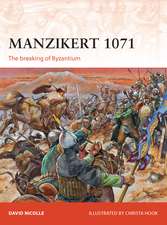Mamluk History through Architecture: Monuments, Culture and Politics in Medieval Egypt and Syria
Autor Nasser Rabbaten Limba Engleză Hardback – 20 sep 2010
Preț: 781.96 lei
Preț vechi: 1117.70 lei
-30% Nou
Puncte Express: 1173
Preț estimativ în valută:
149.62€ • 156.64$ • 123.81£
149.62€ • 156.64$ • 123.81£
Carte tipărită la comandă
Livrare economică 05-19 aprilie
Preluare comenzi: 021 569.72.76
Specificații
ISBN-13: 9781845119645
ISBN-10: 1845119649
Pagini: 276
Ilustrații: 72 b/w integrated
Dimensiuni: 189 x 246 x 25 mm
Greutate: 0.98 kg
Editura: Bloomsbury Publishing
Colecția I.B.Tauris
Locul publicării:London, United Kingdom
ISBN-10: 1845119649
Pagini: 276
Ilustrații: 72 b/w integrated
Dimensiuni: 189 x 246 x 25 mm
Greutate: 0.98 kg
Editura: Bloomsbury Publishing
Colecția I.B.Tauris
Locul publicării:London, United Kingdom
Notă biografică
Nasser Rabbat is the Aga Khan Professor of Islamic Architecture at MIT and Director of the Aga Khan Program for Islamic Architecture. He was educated at the University of Damascus, UCLA and MIT. His previous books include 'The Citadel of Cairo: A New Interpretation of Royal Mamluk Architecture' and, in Arabic, 'The Culture of Building and Building Culture'.
Cuprins
IntroductionPart A- Critiquing Mamluk SourcesChapter 1. The Changing Concept of Mamluk in the Mamluk Sultanate in Egypt and Syria Chapter 2. Representing the Mamluks in Mamluk Historical WritingChapter 3. Perception of Architecture in Mamluk SourcesChapter 4. Architects and Artists in Mamluk Society: The Perspective of the SourcesPart B- Architecture as HistoryChapter 5. The Mosaics of the Qubba al-Zahiriyya in Damascus: A Classical Syrian Medium Acquires a Mamluk SignatureChapter 6. The Militarisation of Taste in Medieval Bilad al-Sham Chapter 7. Al-Azhar Mosque: An Architectural Chronicle of Cairo's HistoryPart C- Architecture and LanguageChapter 8. Documenting Buildings in the Waqf SystemChapter 9. The Iwans of the Madrasa of Sultan HasanChapter 10. Qasr: An agent of Monumentality in Mamluk Architecture Chapter 11. Mamluk Throne Halls: Qubba or IwanPart D- Architecture as Cultural IndexChapter 12. Writing the History of Islamic Architecture in CairoChapter 13. The Ideological Significance of the Dar al-'Adl in the Medieval Islamic OrientChapter 14. 'Ajib and Gharib: Artistic Perception in Medieval Arabic SourcesChapter 15. The Formation of the Neo-Mamluk Style in Modern Egypt















